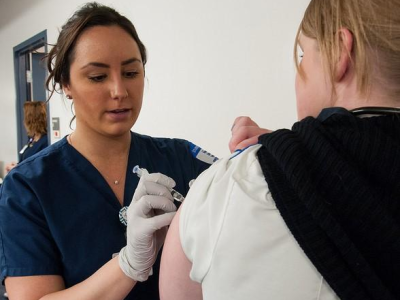Our weekly wrap-up of antimicrobial stewardship & antimicrobial resistance scans
Paper calls for more engagement on dental antibiotic stewardship
A paper today in Clinical Infectious Diseases calls for more engagement between antibiotic stewardship programs (ASPs), dentists, and orthopedic surgeons to curb unnecessary dental antibiotic prophylaxis.
Nationwide, dentists are the top specialty prescriber of antibiotics, accounting for 10% of all antibiotic prescriptions in the United States. Most of these prescriptions are given prior to dental procedures to prevent infections in patients with cardiac conditions and prosthetic joints. But recent research has found that more than 80% of these prescriptions are unnecessary.
One reason is that guidelines for prophylactic dental antibiotic prescribing in the patients have changed over the years. In particular, recent guidelines from the American Academy of Orthopedic Surgeons have stopped recommending antibiotic prophylaxis for patients with prosthetic joints, while guidelines from the American Dental Association and American Heart Association have limited the types of cardiac patients who should receive antibiotics before dental procedures.
But as researchers from the Ohio State University write in the paper, despite the new recommendations, orthopedic surgeons still see high value and low risk in antibiotic prophylaxis, and dentists are put in a tough position when patients ask for antibiotics on the advice of their orthopedic surgeon. They also note, based on feedback from a recent town hall forum they held with orthopedic surgeons and dentists, that many consider dental antibiotic prophylaxis to be a form of defensive medicine.
Based on their review of guidelines and findings from the forum, the authors of the paper recommend that ASP coordinators should meet with local orthopedic and dental societies to address guidelines and controversies and to improve knowledge gaps about adverse drug reactions, and should provide education to dentists and orthopedic surgeons via webinars. They also suggest that dentists and orthopedic surgeons in the same communities work together to build consensus on antibiotic prophylaxis.
"Similar to the current US opioid crisis, which has greatly impacted dentists and OS [orthopedic surgeons] to reconsider every opioid dose and duration, we believe community based dental stewardship must advocate for both dentists and OS to rethink any AP [antibiotic prophylaxis] prescribed with a goal towards far less," the authors write.
Nov 15 Clin Infect Dis abstract
HHS funds 3 host-response rapid tests to diagnose viral, bacterial illnesses
The US Department of Health and Human Services (HHS) will provide an initial $6 million over 14 months to Inflammatix, of Burlingame, California, for developing three point-of-care host-response diagnostic tests to distinguish viral infections from bacterial ones, HHS said in a news release yesterday.
The tests—HostDx Fever, HostDx Sepsis, and HostDx FeverFlu—involve diagnostics technology that reads gene expression patterns in the immune system to distinguish bacterial from viral infections and determines the severity within 20 to 30 minutes. HostDx Fever is designed for ambulatory care settings, HostDx Sepsis is geared toward hospital patients, and HostDx FeverFlu is designed for both outpatient and inpatient settings.
Funds will be provided by the Biomedical Advanced Research and Development Authority (BARDA), part of the HHS Office of the Assistant Secretary for Preparedness and Response. The contract could grow to as much as $64.9 million through 2027 for Inflammatix to complete the additional work needed to apply for Food and Drug Administration approval.
Determining quickly whether an illness is caused by a virus or a bacterium is crucial in knowing whether antibiotics are needed. "Rapid diagnostics are a cornerstone of our strategy to protect Americans from many bacterial and viral infections; earlier diagnosis can empower patients to take action to reduce disease transmission," said BARDA Director Rick Bright, PhD. "Diagnostics that can provide rapid results to patients and doctors will support stewardship of antibiotics and save lives."
Nov 14 HHS news release
European data show antibiotic use, resistance dropping or stable
Antibiotic use for and antimicrobial resistance (AMR) in Escherichia coli and Klebsiella pneumoniaeacross Europe have decreased or stabilized in recent years, according to a report yesterday in Eurosurveillance.
To examine trends, European researchers analyzed population-weighted data across the European Union/European Economic Area from the European Surveillance of Antimicrobial Consumption Network (ESAC-Net) and the European Antimicrobial Resistance Surveillance Network (EARS-Net) for 2001 through 2018. They studied trends in consumption of third-generation cephalosporins, fluoroquinolones, and carbapenems and for AMR in E coli and K pneumoniae.
The authors found that consumption of third-generation antibiotics rose slightly in the earlier years of the study but then declined in the community and held steady in the hospital sector. Resistance to third-generation cephalosporins rose steadily till about 2013 then plateaued.
Fluoroquinolone use held fairly steady throughout the study period, while resistance to the drug followed a pattern similar to third-generation cephalosporins, though fluoroquinolone resistance in hospital samples plateaued earlier, in 2006. Carbapenem consumption climbed more dramatically than for the other drugs until 2013, then declined in each subsequent year, while resistance to that antibiotic class rose sharply till 2013 and has been fairly stable since.
The authors write that their results indicate that recent public health efforts promoting prudent antibiotic use are showing results. "Nevertheless," they add, "percentages of AMR reported here were comparatively much higher in 2018 than in 2002/06 and trends appear to stabilise or slow down rather than decrease in recent years."
Nov 14 Eurosurveill study
Pakistan to launch typhoid vaccine campaign to fight 'superbug' strain
Pakistan has become the first country to routinely use the typhoid conjugate vaccine as it combats an outbreak of multidrug-resistant typhoid, according to Reuters. The vaccination campaign will be funded by GAVI, the vaccine alliance.
The "superbug" strain of typhoid has sickened about 11,000 Pakistanis since 2016. Children between the ages of 9 months and 15 years will be targeted in the vaccination campaign, and the vaccine affords up to 5 years of protection from the disease. The campaign will launch in Sindh province.
Children are most at risk for contracting typhoid, which is caused by Salmonella enterica serotype Typhi bacteria and transmitted through contaminated food and water. The disease most commonly causes fever, nausea, and stomach pain, and in severe cases can be fatal.
The case-fatality rate for Pakistan's current outbreak is around 1%, but experts say that number could jump to 20% if the strain becomes resistant to the last remaining antibiotic that can kill it. There is also the risk of the strain spreading internationally, as travelers to Pakistan from the United States, Australia, Britain, Canada, Denmark, and Taiwan have already contracted the disease.
Nov 15 Reuters story
AHRQ publishes stewardship toolkit for hospitals
Originally published by CIDRAP News Nov 14
The Agency for Healthcare Research and Quality (AHRQ) has released a new toolkit to improve antibiotic use in acute care hospitals.
The toolkit consists of presentations, slides, posters, and other documents that provide guidance on how to develop a culture of safety around antibiotic prescribing, how to develop and improve antibiotic stewardship programs, and how to learn and disseminate best practices for the diagnosis and treatment of common infectious disease syndromes. It also includes an explanation of the "Four Moments of Antibiotic Prescribing," a step-by-step approach that clinicians can use to achieve optimal antibiotic prescribing.
The toolkit is based on the experiences of more than 400 US hospitals that took part in AHRQ's Safety Program for Improving Antibiotic Use, a 5-year project to improve antibiotic prescribing practices across acute care, ambulatory care, and long-term care facilities in the United States.
Nov 13 AHRQ toolkit
New York names hospitals, nursing homes with Candida auris cases
Originally published by CIDRAP News Nov 14
New York has become the first state to release the names of medical facilities that have treated patients with Candida auris, according to a report yesterday in the New York Times.
The list published by the Times includes 64 hospitals and 103 nursing homes (mostly concentrated in Manhattan, Brooklyn, and Queens) that have cared for patients who were either infected or colonized with the multidrug-resistant fungus. New York health officials told the paper they decided to release the names of the facilities to provide transparency to consumers and help curtail C auris, which has spread rapidly in healthcare settings in New York and other states since first being detected in the United States in 2016.
Of the 836 confirmed and probable C auris infections reported to the Centers for Disease Control and Prevention (CDC), 392 have been in New York, with 231 reported in Illinois and 159 in New Jersey. Ten other states have reported cases. An additional 1,624 US patients have been found to be colonized with C auris.
In its updated report on the antibiotic resistance threats in the United States, the CDC added C auris to the list of drug-resistant pathogens it considers to be urgent threats. The fungus has shown resistance to all three classes of antifungal medication, and more than 1 in 3 patients with invasive C auris infections dies.
Nov 13 New York Times story
Oct 29 CDC case count
Study finds antibiotic prescriptions have fallen by nearly a third in Finland
Originally published by CIDRAP News Nov 14
Antibiotic prescriptions have fallen by 29% in Finland over the past decade, according to a study commissioned by pharmaceutical company Pfizer.
Using health insurance data from Kela, the Finnish government agency in charge of social benefits, Pfizer researchers found that nearly 1 million fewer antibiotic prescriptions were filled in Finland in 2018 compared with 2008. Antibiotic prescribing for children ages 0 to 4 fell by 60%, while the number of antibiotic courses prescribed for children ages 5 to 7 fell by 43%. The smallest decline in antibiotic prescribing, 17%, was in adults over 65.
Pekka Honkannen, Emeritus Professor of General Medicine at the University of Oulu, notes in a translated Pfizer press release that the decline in antibiotic prescribing in children is likely linked to the inclusion of a pneumococcal vaccine in the country's national vaccination program.
Recent data from the European Centre for Disease Prevention and Control show that Finland has the ninth lowest antibiotic prescribing rate in Europe.
Nov 13 Pfizer press release
Latest Scottish report shows drop in antibiotic use, stable resistance levels
Originally published by CIDRAP News Nov 13
In an annual report for 2018, public health officials in Scotland yesterday said total antibiotic use in humans has dropped by 6.2% since 2014, and resistance has stayed mainly stable.
The findings, from Health Protection Scotland, for the first time include data on animal antimicrobial use from small-animal veterinary practices and data on environmental antimicrobial resistance.
Among other key findings on antimicrobial use, the authors report that, since 2014, levels have declined by 10.2% in primary care but increased by 16.0% in acute care hospitals. For 2018, more than one in four people in Scotland (27.3%) received at least one antibiotic course in primary care settings. The new information from small animal veterinary practices found that at least one in five consultations resulted in a prescription for at least one antibiotic.
Regarding latest trends on antibiotic resistance in humans, infections involving carbapenemase-producing bacteria have increased significantly since 2014, but there was no change between 2017 and 2018. Resistance to vancomycin, a key antibiotic used to treat resistant infections, has increased to 43.2% in some infection types, and in 2018, nearly 10% of gonorrhea cases showed some resistance to azithromycin.
On a positive note, the level of resistance to antibiotics prescribed for E coli bacteremia and similar infections has been stable of the past 5 years, the authors found. And in 2018, two thirds of Salmonella infections in animals were fully susceptible to antibiotics tested, showing no change from 2017. The group said the level of antibiotic-resistant infections in animals has been relatively stable since 2014.
Nov 12 Health Protection Scotland report
Study: Antibiotic prescriptions rates high in Japan
Originally published by CIDRAP News Nov 13
A study today in the International Journal of Infectious Diseases surveyed Japanese antibiotic prescription rates from 2012 to 2015 via electronic health insurance claims and found that 56% of prescriptions were written for infections for which antibiotics are rarely indicated.
The national health insurance database claims showed 659 million infectious disease visits from April 2012 through March 2015 across the country, with antibiotics prescribed at 266 million visits (704 prescriptions per 1,000 population per year). Antibiotics were most commonly prescribed for upper respiratory infections, with bronchitis being the most frequently cited diagnosis for prescriptions (58.3% of prescriptions, or 184 prescriptions per 1,000 population per year). Other high rates were for viral upper respiratory infections (40.6%), pharyngitis (58.9%), and sinusitis (53.9%).
Gastrointestinal infections accounted for 26.1% of prescriptions. The vast majority (86%) of oral antibiotics prescribed were broad-spectrum (third-generation cephalosporins, macrolides, or quinolones), and antibiotics was prescribed approximately 6.6 times more frequently for infections that did not require antibiotics than infection for which antibiotics are usually indicated, the authors said.
"Prescriptions of oral antibiotics should be reduced at least 50% based on our data, showing that >50% of them (391 per 1000 population) were prescribed for conditions where antibiotics are generally not indicated," the authors concluded. "Broad-spectrum antibiotics were too frequently prescribed and most of them were prescribed for acute respiratory infections, which should be the main targets of antimicrobial stewardship intervention."
Nov 13 Int J Infect Dis study
Study: Pre-surgical antibiotic prescriptions often inappropriate
Originally published by CIDRAP News Nov 12
A new study that surveyed 22.5% of Australia's hospitals from January 2016 through June 2018 found that surgical antimicrobial prophylaxis (SAP) was often inappropriate, because of both incorrect timing and overly long treatment. The study appears in JAMA Network Open.
A total of 15,395 prescriptions (10,740 procedural and 4,655 postprocedural) were audited for appropriateness by pharmacists, nurses, and infectious disease physicians who were trained in study methodology. They found that only 48.7% of all total prescriptions were appropriate. Appropriateness varied among types of surgeries: Only 33.7% (95% confidence interval [CI], 26.3%-41.2%) of dentoalveolar surgical SAP prescriptions were appropriate, while 68.9% of neurosurgey prescriptions were appropriate.
"The adjusted appropriateness of postprocedural prescriptions was also low, ranging from 21.5% (95% CI, 13.4%-29.7%) for breast surgery to 58.7% (95% CI, 47.9%-69.4%) for ophthalmological procedures. The most common reason for inappropriate procedural SAP was incorrect timing (44.9%), while duration greater than 24 hours was the most common reason for inappropriate postprocedural SAP (54.3%)," the authors wrote.
Among procedural prescriptions, 11.7% were prescribed when procedural SAP was not deemed to be required, the authors said.
In a commentary on the study, two researchers said the study was well-designed, but ultimately the audits were too time-consuming. Instead they suggested conducting smaller-scale audits more frequently, and using antibiotic consumption data to assess SAP.
Nov 8 JAMA Netw Open study
Nov 8 JAMA Netw Open commentary
Highly deadly Klebsiella pneumoniae strain identified in Brazilian hospital
Originally published by CIDRAP News Nov 12
A retrospective analysis of adult bloodstream infections involving carbapenemase-producing K pneumoniae (KPC-KP) at a Brazilian teaching hospital identified an emerging strain linked to high mortality rates. A team from Brazil and Cardiff University in the United Kingdom reported its findings today in Clinical Infectious Diseases.
For the study, the researchers looked at cases from January 2014 to December 2016 to assess the molecular epidemiology and impact on 30-day all-cause mortality. Of 165 KPC-KP cases, the endemic CC258 group was predominant (66%), followed by ST16 (12%). Though the overall 30-day mortality rate was 60%, it was much higher for ST16, for which 95% of the cases were fatal.
The team found no differences in patient severity scores and baseline clinical variables, but they did find that risk factors for fatal outcomes were presence of ST16 and septic shock.
Further investigation found that the ST16 clone carried up to 14 resistance genes and was highly pathogenic in moth larvae. "Our results suggest that even in endemic settings, highly virulent clones can rapidly emerge demanding constant monitoring," they wrote.
Nov 12 Clin Infect Dis abstract
Review: FDA guidance often touts indirect end points for antimicrobial trials
Originally published by CIDRAP News Nov 12
A systematic review today of 27 US Food and Drug Administration (FDA) guidance documents on developing new anti-infective agents has determined that the documents frequently recommend as study end points indirect measures of patient benefit—rather than direct measures, such as symptom resolution or survival—raising questions about whether the FDA is following its own standards when it comes to new antimicrobial drugs such as antibiotics.
For the study, published in JAMA Internal Medicine, Harvard University scientists included 22 guidance in their review. The documents included recommendations for primary end points in 27 "pivotal" clinical trials for drugs designed to combat infectious diseases. An end point is an event or outcome that can be objectively measured to see if the drug benefits patients.
The investigators found that 21 of 27 indications recommended surrogate—or indirect—outcomes as either the sole primary end point or as one or more components. What's more, none of the recommendations for the use of surrogate end points matched the regulatory and scientific conditions favoring indirect outcomes in place of clinical outcomes, the authors reported.
The authors conclude, "Existing guidance documents should be updated and revised to recommend appropriate clinical outcomes consistent with general scientific and regulatory parameters."
A related commentary in the same journal, however, notes that surrogate end points are not necessarily bad, such as with uncomplicated gonorrhea, for which the primary end point is microbiological cure. "This surrogate measure of microbiological cure meets none of the 3 criteria previously listed for surrogate trial end points," write the commentary authors, Paul Volberding, MD, and Henry Chambers, MD. "Nonetheless, both clinically and from a public health perspective, eradication of the organism is the important outcome."
The commentators, from the University of California San Francisco, add, "The true debate is not whether to use surrogate markers. Rather, the debate is about when surrogate markers are meaningful."
Nov 11 JAMA Intern Med systematic review
Nov 11 JAMA Intern Med commentary
Study shows decline in C difficile incidence at VA hospitals
Originally published by CIDRAP News Nov 11
A retrospective analysis of Veterans Administration (VA) patients who had stool testing for Clostridiodes difficile shows an overall decrease in C difficile infection (CDI) over the course of a decade, with temporal increases linked to implementation of molecular testing methods, researchers reported today in Infection Control and Hospital Epidemiology.
From 2006 through 2016, 472,346 VA patients were tested for C difficile and 68,995 new cases of CDI were reported. The incidence of total inpatient CDI per 10,000 patient-days decreased from 16.81 in 2006 to 13.66 in 2016, and incidence of hospital-onset healthcare facility-associated (HO-HCFA) CDI fell from 10.87 to 6.41. For both CDI and HO-HCFA CDI, temporal increases in incidence observed in 2011 were associated with increased use of molecular-based testing methods such as polymerase chain reaction (PCR) tests (P < .0001). Decreases for both CDI and HO-HCFA CDI were associated with reduced use of fluoroquinolones (P < .0001), clindamycin (P = .0006), and third-generation cephalosporins (P < .0002). Implementation of VA mandatory reporting of HO-HCFA CDI in 2012 did not influence overall CDI rates (P = .24) or HO-HCFA CDI rates (P = .72).
The analysis also found that the overall crude 30-day mortality rate for CDI fell from 2.17 deaths per 10,000 patient-days in 2006 to 1.41 in 2016. The decrease in mortality correlated with PCR testing (P= .0003) but not with decreased antibiotic use or with mandatory VA reporting.
The authors of the study conclude, "Controlling CDI is likely multifactorial. Although the VA initiative to report cases of hospital-acquired CDI was not significant in our model, the advent of stewardship programs throughout the VA and reductions in the use of third-generation cephalosporins, fluoroquinolones, and clindamycin were significantly associated with reduced rates of CDI."
Nov 11 Infect Control Hosp Epidemiol abstract
UK antibiotic development group to work on metallo-beta-lactamase inhibitor
Originally published by CIDRAP News Nov 11
UK-based antibiotic and diagnostic development group the AMR Centre announced today that is has selected a preclinical candidate from its program to address antibiotic resistance caused by metallo-beta-lactamase (MBL) enzymes.
According to an AMR Centre press release, the MBL inhibitor program is focused on a novel small molecule that inhibits a range of MBL enzymes—including NDM-1, IMP, and VIM—and has been shown in lab studies to restore the function of existing beta-lactam antibiotics, which are inactivated by MBLs. The goal is to combine the molecule with carbapenems to treat serious, multidrug-resistant infections caused by gram-negative, MBL-harboring bacteria.
"Our mission is to overcome resistance mechanisms and develop new treatments for serious infections," AMR Centre Executive Director Peter Jackson, PhD, said. "Our MBL inhibitor will be one of the first and, we hope, most effective broad-spectrum therapies against the emerging class of superbugs coming out of India and China."
Clinical trials are scheduled to begin in late 2020.
Nov 11 AMR Centre press release
Dutch study measures ESBL carriage in dogs, cats, and their owners
Originally published by CIDRAP News Nov 11
A nationwide study by Dutch researchers has found that more than 10% of dogs in the Netherlands carry extended-spectrum beta-lactamase-producing Enterobacteriaceae (ESBL-E). The findings appear today in the Journal of Antimicrobial Chemotherapy.
For the cross-sectional study, which aimed to identify the prevalence, risk factors, molecular characteristics, persistence, and acquisition of ESBL-E in dogs and cats, the researchers randomly invited Dutch residents to fill out a web-based questionnaire and provide a fecal sample from their dog or cat. Participants were also invited to provide a fecal sample so researchers could investigate co-carriage in human-pet pairs belonging to the same household.
Overall, 550 pairs of fecal samples from humans and dogs and 282 pairs of fecal samples from humans and cats were submitted. The prevalence of ESBL-E carriage in these cohorts was 3.8% for human participants, 10.7% for dogs, and 1.4% for cats. Among the dogs and the cats, the most abundant ESBL gene were blaCTX-M-1 and blaCTX-M-15. The persistence of ESBL-E carriage in dogs was 57.1% at 1 month and 42.9% at 6 months. The primary risk factors for ESBL-E carriage in dogs was eating raw meat (odds ratio, 8.8; 95% CI, 4.7 to 16.4). Risk factors could not be determined for cats.
No ESBL-E co-carriage was found between cats and their owners, but in five households, both the human and dog fecal samples were positive for the same ESBL gene, which was more than expected based on chance. Whole-genome sequencing in three of the human-dog pairs found that the isolates were nearly identical.
The authors of the study say the observed ESBL-E co-carriage between humans and their dogs suggests either clonal transmission between humans and pets within the same household, or exposure to the same source.
Nov 11 J Antimicrob Chemother study










